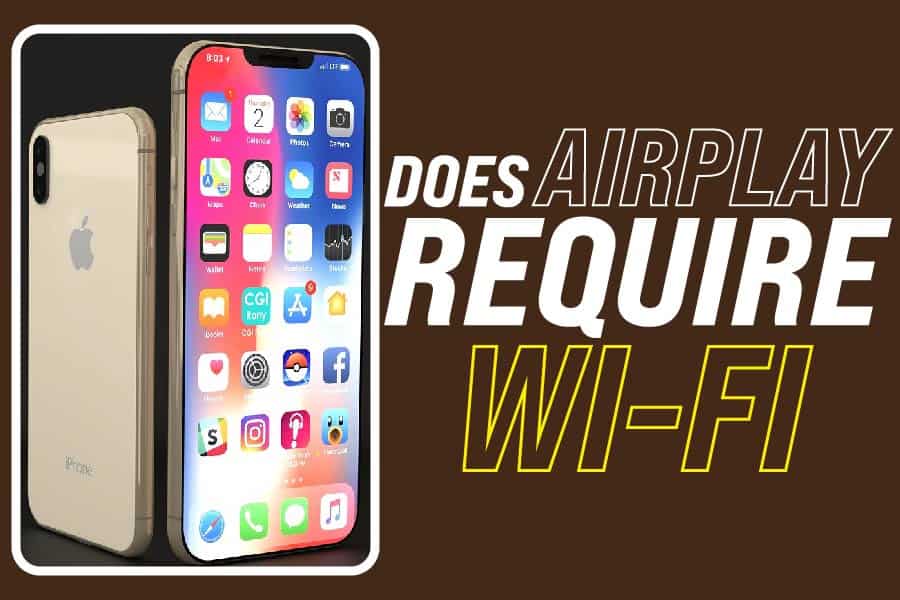
AirPlay is a wireless multimedia casting service developed for Apple products. It enables users to stream media content across multiple Apple devices that support the feature.
It is similar to Google’s very own Chromecast service, which has the same level of functionality.
AirPlay also enables users to cast content from an Apple to a non-apple device seamlessly. The only caveat is that the non-Apple device has to support the functionality.
Apple released the first rendition of AirPlay in 2010 and has since released an improved version called AirPlay2.
The 1st release was exclusively audio-based. It was created to enable Apple users to take advantage of the iTunes store. Other forms of media were later supported in subsequent updates.
It is clear that to support wireless connectivity, there has to be a supporting medium. So,
Does AirPlay Require Wi-Fi?
AirPlay does not require a Wi-Fi network to cast. You can use a peer-to-peer connection between devices that support AirPlay as a workaround.
It, however, will not work if you are streaming content on your device. The peer-to-peer connection works if the content you are sharing is on your local storage.
AirPlay vs. Bluetooth, Which Is Better
AirPlay and Bluetooth share several similarities. They offer users a way to share files and use Audio files across multiple devices. The services also differ widely in terms of their range of usage.
Let us look at how they stack up compared to each other.
1. File Transfer
Both Bluetooth and AirPlay can be used to send files between compatible devices. The difference boils down to the transfer speeds across the networks.
Bluetooth 5.2 is relatively limited in terms of data transfer across devices. It can only sustain a maximum data transfer speed of 2 MBPS.
The speed limitation makes it far from ideal for sharing large files. File transfer is, however, not the primary use for Bluetooth.
AirPlay, on the other hand, does not support any form of file transfer across devices.
2. Multimedia Support
AirPlay supports an extensive range of media. It can seamlessly cast video, audio files in multiple formats, pictures, etc.
It archives this with no changes in quality. Airplay is limited to ALAC, AAC, and MP3 format audio files.
Bluetooth is only capable of casting audio files to compatible devices. It does not include support for video or pictures.
3. Support Across Devices
While AirPlay is usable with Apple devices, it has a small range of support for non-Apple devices.
The number of devices supported is scarce. Only particular high-end devices include the option to cast content over AirPlay.
Bluetooth enjoys much support with its devices. All AirPlay devices have Bluetooth functionality. Bluetooth is available on both high-end and mid-range devices.
4. Range
The range of your Wi-Fi network limits the support range for AirPlay. All the devices using AirPlay must be networked and fall within the radius of the Wi-Fi signal. A stable and reliable connection helps in casting over great distances.
The range of Bluetooth varies depending on the version. Bluetooth 5.2 has a maximum range of 400 meters.
5. Lossless Compression
Lossless compression is a data compression technique that aids in the transfer of data such that no bits are dropped.
The implications are that there will be zero dips in the quality of data transfer, regardless of distance.
AirPlay takes advantage of Lossless Compression. This can be seen when streaming demanding content such as 4K video over great distances, without changes in resolution.
Unfortunately, Bluetooth does not use lossless compression. As a result, you can tell that there are significant dips in audio quality. It is especially evident if you happen to be on the outer fringes of the signal’s radius.
How To Set Up AirPlay
As with most Apple services, it is pretty easy to set up and use AirPlay for both audio and video. Setting up airplay for audio and video is slightly different.
For audio:
You must ensure that the device you are streaming to is compatible with AirPlay.
Step 1: Open ‘Control Center’ on your device
Swipe down from the top right-hand side of your screen to access the control center option.
Step 2: Activating the controls
Tap and hold down the upper-right hand corner. Tap the AirPlay option.
Select the speakers that you wish to use to stream your audio files. Note that you can select multiple speakers at the same time.
Streaming Audio files on Mac OS
Step 1: Open ‘Menu’, and select ‘Control Center’.
Step 2: Go to ‘Sound’ and click on the ‘AirPlay’ icon.
Step 3: Select the speakers you wish to use to stream your audio files.
To stream video files:
Ensure that the device you are casting on is compatible with AirPlay
Step 1: Connect your devices to the same Wi-Fi network.
Step 2: Open the video on your device.
Step 3: Find the AirPlay icon. The icon should be located on the bottom left-hand corner of your device.
Step 4: Connect your device to the list of available devices.
To mirror your phone to a larger screen:
Step 1: Ensure that the devices are linked to the same wi-Fi network.
Step 2: Open ‘Control Center’ on your device.
Swipe down from the top right-hand side of your screen to access the control center option.
Step 3: Tap the icon that appears as two overlapping screens.
Step 4: Select your desired device from the list of devices available.
Step 5: Enter the password you use to unlock your device on the mirror screen.
If you do not find your device listed, ask the manufacturer whether it supports Airplay.
Why Is AirPlay So Good?
There are several reasons why using AirPlay is ideal. They include
1. Siri
AirPlay can take advantage of Apple’s AI to communicate with your devices. The use of voice commands makes the user-experience great. Siri allows you to have a hands-off approach. You would tell the AI to play a specific video to a compatible screen on your device.
2. 4K
AirPlay can easily upscale the video content from one device to 4K on the other device. It is only applicable to devices that are compatible with 4K. It enables you to enjoy high-resolution content on compatible devices without worrying about down-scaling.
3. Spatial audio
With AirPlay, you can enjoy spatial audio. You can stream spatial audio files in the ALCA, AAC, and MP3 format. You can now enjoy incredible surround sound wirelessly without loss in audio quality.
There is no limit to the number of active connections to the network. It enables users to play audio files on multiple speakers.
5. No HDMI
Using AirPlay eliminates the need to have HDMI cables or connect your device to a dongle. AirPlay overcomes the limitation of HDMI in that you can connect to many devices in many locations simultaneously.
AirPlay will also spare you the cost of purchasing multiple HDMI cables.
6. Seamlessness
The connection and pairing process for devices that use this service is fast and easy. It is intuitive and practical. The interface on IOS makes it easy to navigate to your desired device and connect.
7. Security
The network on IOS and Mac OS is very secure. You would need to access the passcode of a device to enable streaming. It acts as multi-factor authentification.
8. Lossless Compression
Lossless compression is perhaps the most significant advantage of using AirPlay. The ability to retain the quality of a file regardless of transfer distance is essential. Lossless compression technology makes AirPlay reliable.
Shortcomings Of AirPlay
Airplay is fast and reliable. Just like with all products, it does have some cons. These are:
1. Wi-fi functionality
To access the full range of functionality for your device, you will need a connection to the internet. Streaming is only possible over a reliable Wi-Fi network.
Note that you can use the service using a Peer-to-Peer connection, but this significantly limits the functionality.
2. Battery life
Streaming content using AirPlay requires that your device be connected to a network at all times. It will ultimately drain your machine faster than using an HDMI hub.
3. Support
The most significant limitation to AirPlay is the range of devices that support it. Only Apple-certified devices can use the service. Other similar services like Chromecast offer better support for devices.
Conclusion
AirPlay is a seamless and reliable casting service offered by Apple. It works excellently between Apple devices but is also supported by specific non-apple products. The service provides exceptional audio and visual quality. It works well with devices that support spatial audio and even 4K.
Wi-Fi is not a requirement for AirPlay, though using the service without a Wi-Fi connection can be pretty limiting. Wi-Fi makes the experience better for users.
Similar Posts:
- How To Turn On Airplay On Iphone 6?
- How To Connect Iphone To Sharp Tv?
- How To Connect Pandora To Car Bluetooth Iphone?
- How To Turn Off Airplay On Iphone 11?
- How To Connect Iphone To Samsung Smart Tv Via Bluetooth?
- How To Mirror Iphone To Panasonic Tv?
- How To Mirror Iphone To Roku Without Wifi?
- How To Connect Vizio Tv To Iphone Hotspot?
- Does Android Support Multiple Bluetooth Connections?
- How To Mirror My Iphone To Tv?
